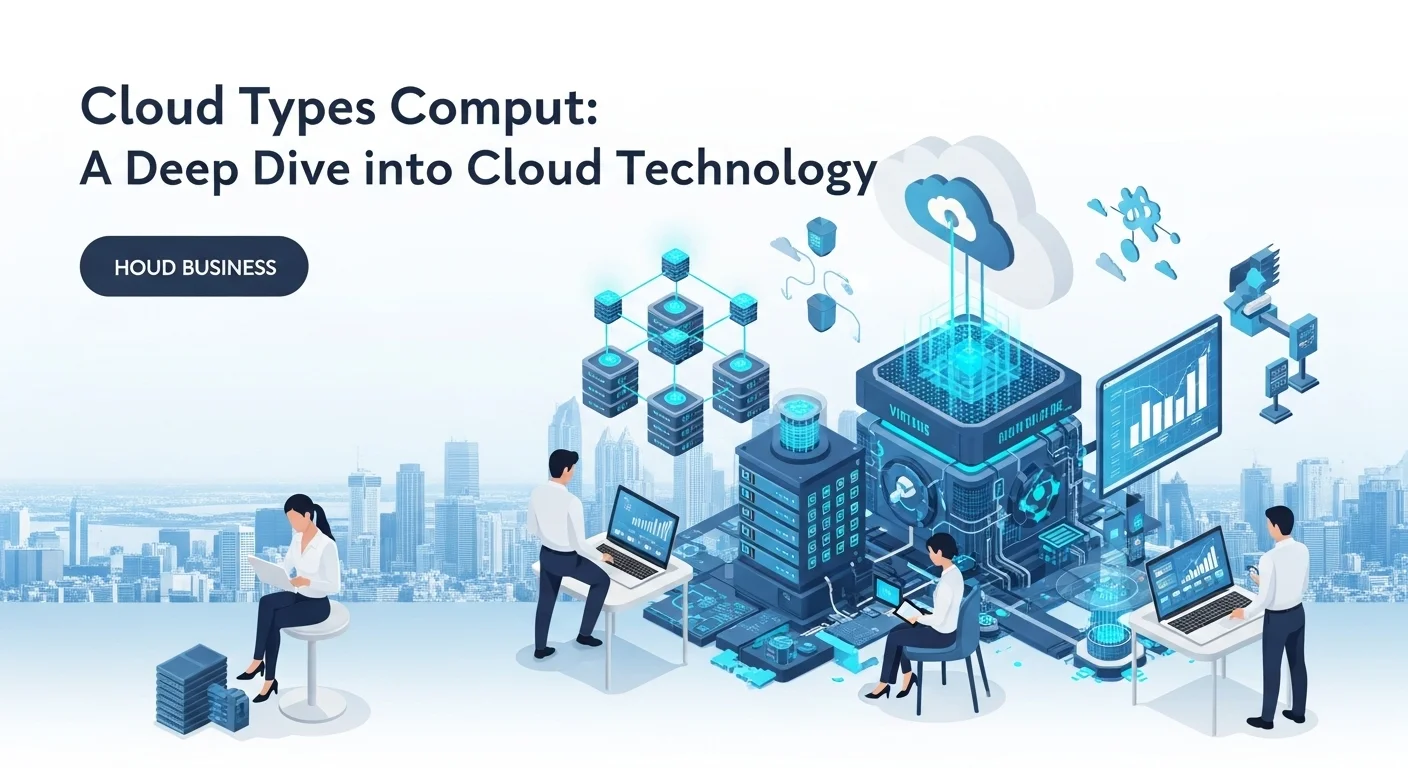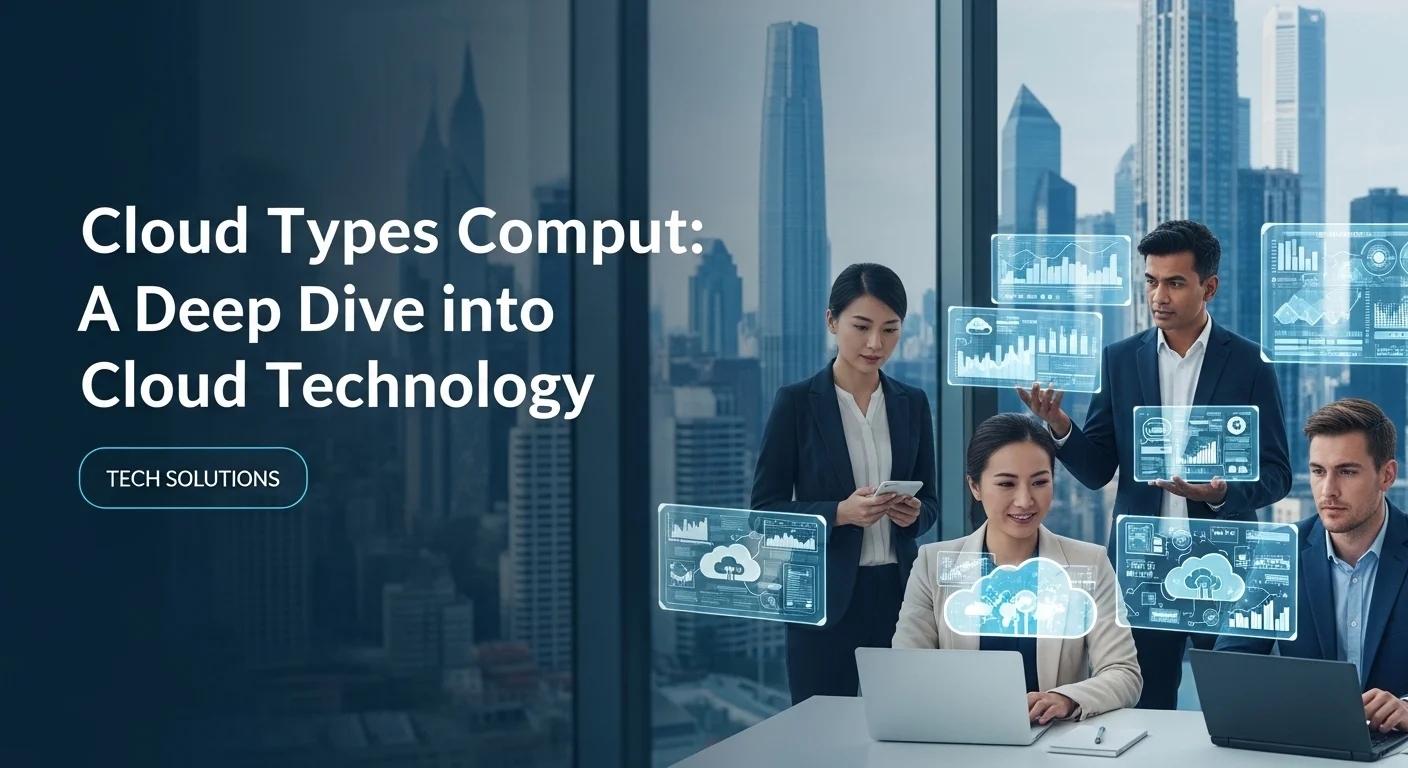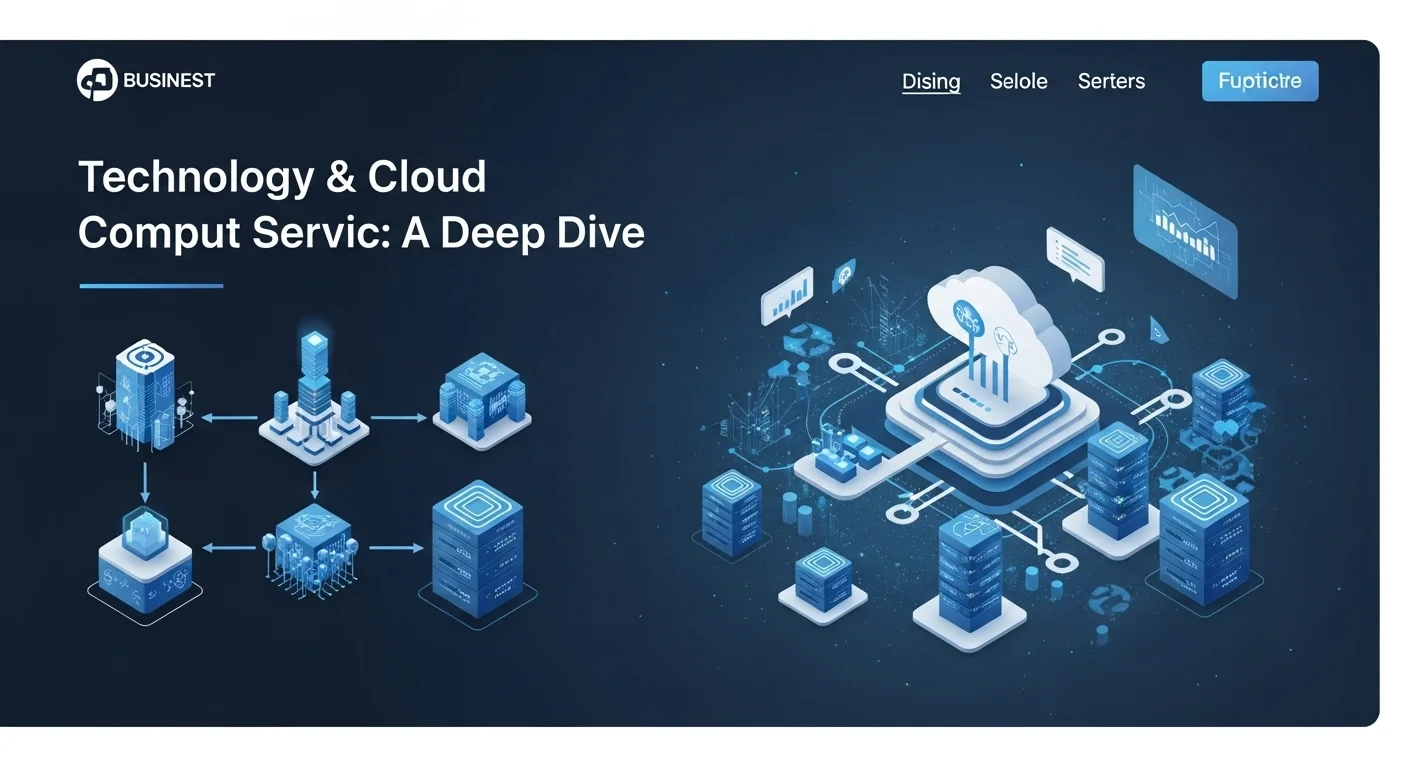Cloud Computing Explained: A Simple Guide to IaaS, PaaS, and SaaS

Executive Summary
Ever wondered what people mean when they talk about 'the cloud'? It's not as complicated as it sounds. For years, I've helped businesses move from clunky, expensive hardware to flexible, powerful cloud solutions. It's a game-changer, but the jargon can be intimidating. This guide is my way of breaking it all down for you. We'll walk through the main types of cloud computing—like IaaS, PaaS, and SaaS—and figure out what they actually mean for you or your business. We'll also explore the difference between public, private, and hybrid clouds. My goal is to give you the clear, straightforward insights you need to understand how these technologies work and how you can use them to innovate and grow. Think of this as the friendly manual I wish I had when I first started.
Table of Contents
Table of Contents
What is Cloud Computing and Why Does It Matter?
In the tech world, we love our buzzwords, but 'cloud computing' is one that has truly changed everything. At its heart, cloud computing is about accessing computing resources—like servers, storage, and software—over the internet instead of hosting them on your own physical hardware. Think of it like switching from a DVD collection to Netflix. You no longer need to own and manage the physical media; you just stream what you need, when you need it. I've been in this industry long enough to remember the 'before times,' when launching a new application meant buying expensive servers, waiting weeks for them to arrive, and finding a place to store them. It was slow, costly, and rigid. The cloud flipped that model on its head.
The importance of understanding the different types of cloud computing services is massive because it's the engine behind modern digital life. It gives businesses incredible agility. Instead of spending a fortune on hardware upfront (a capital expense), you can rent computing power and pay as you go (an operational expense). This has leveled the playing field, allowing small startups to use the same powerful infrastructure as global corporations. This flexibility fuels everything from your favorite mobile apps and streaming services to complex AI research. Grasping the different types of cloud services is the first, most crucial step for anyone looking to build, scale, or simply operate more efficiently in today's digital landscape.
The Core Deployment Models: Public, Private, Hybrid, and Multicloud
The first thing to understand is where the cloud infrastructure lives. This is defined by the deployment model. I've worked with clients on all four, and each has its place.
1. Public Cloud: This is what most people think of as 'the cloud.' A third-party provider, like Amazon Web Services (AWS), Microsoft Azure, or Google Cloud, owns and operates massive data centers, and you rent a slice of their hardware. It's a shared environment, but your data is kept separate and secure. The biggest win here is the sheer scale. You get incredible reliability and can scale up or down in minutes, and you don't have to worry about any hardware maintenance. It's the go-to for most new projects due to its cost-effectiveness and flexibility.
2. Private Cloud: Imagine having the benefits of the cloud—like on-demand resources—but the entire infrastructure is dedicated exclusively to your organization. That's a private cloud. It can be in your own data center or hosted by a third party, but you're the only tenant. I've seen this used mostly by financial institutions and government agencies that have very strict security or regulatory needs. You get more control and customization, but it comes with a higher price tag and the responsibility of managing it.
3. Hybrid Cloud: This is the 'best of both worlds' approach, and it's incredibly popular. A hybrid cloud connects a private cloud with a public cloud, letting them work together. A common strategy I recommend is keeping sensitive data (like customer records) on a private cloud while using the public cloud's power for less sensitive tasks, like hosting your public website. This approach lets you balance security, cost, and scalability in a really practical way.
4. Multicloud: Don't confuse this with hybrid. A multicloud strategy means you're using services from *more than one public cloud provider*. For example, you might use Google Cloud for its leading AI tools and AWS for its extensive database services. The goal is to pick the best tool for each job and avoid being locked into a single vendor. It adds complexity, but for many businesses, the flexibility is worth it.
The Essential Service Models: IaaS, PaaS, and SaaS (The Pizza Analogy)
The next layer is the service model, which dictates how much you have to manage yourself. The classic 'pizza as a service' analogy is genuinely the best way I've found to explain this.
1. Infrastructure as a Service (IaaS): This is the most basic building block. You're renting the fundamental IT infrastructure—servers, storage, and networking. In the pizza analogy, IaaS is like your friend giving you a fully equipped kitchen. You get the oven, flour, and ingredients, but you have to make the pizza from scratch. You have total control, from the dough to the toppings. IaaS is perfect for teams that want maximum control and flexibility to build their systems from the ground up, without buying physical hardware. Leaders here are services like Amazon EC2 and Google Compute Engine.
2. Platform as a Service (PaaS): PaaS provides the platform, but not the underlying infrastructure. It handles the servers, operating systems, and databases for you, so you can focus purely on building and running your applications. This is like ordering a pizza for delivery. The pizza place handles all the cooking; you just have to provide the plates and drinks. I've seen development teams accelerate their work dramatically using PaaS because it removes so much operational headache. Services like Heroku or Google App Engine are great examples.
3. Software as a Service (SaaS): This is the model you're probably most familiar with. The software is delivered to you over the internet, usually for a subscription fee. The provider manages everything—the software, the infrastructure, and all the maintenance. This is like going out to a restaurant for pizza. You just sit down, order, and enjoy. You don't worry about the kitchen, the cooking, or the cleanup. Think Google Workspace, Salesforce, or Dropbox. It's the ultimate in convenience and has become the standard for most business software today.

A Deeper Look: The Tech and Strategy Behind the Cloud
Once you've got the basics down, it's fascinating to peel back the layers and see what makes it all tick. A solid grasp of the core technologies and business strategies is what separates a good cloud setup from a great one. For anyone in a technical role, this is where you can really start to architect solutions that are not just functional, but also efficient, scalable, and secure. Let's look under the hood and then talk strategy.
The Technology That Powers the Cloud
Cloud computing feels like magic, but it's built on some incredibly clever technologies. Understanding these helps you appreciate what's happening behind the scenes.
1. Virtualization: This is the foundational technology of the cloud, especially for IaaS. At its core, virtualization uses a piece of software called a hypervisor to let one physical computer act like several separate, virtual computers. Each virtual machine (VM) gets its own share of the CPU, memory, and storage, and it's completely isolated from the others. This is how cloud providers can serve thousands of customers from a single data center, which is what creates the massive cost savings we all benefit from.
2. Containerization: Containers are a lighter, more agile version of virtualization. Instead of creating a whole virtual computer, a container packages up just the application and its dependencies. Containers all share the host machine's operating system, making them incredibly fast to launch and easy to move around. Docker is the most famous tool for creating containers, and Kubernetes is the go-to platform for managing them at scale. In my experience, teams that adopt containers ship better software, faster. They are central to most modern PaaS offerings and a key part of how developers build applications today.
3. Microservices Architecture: In the old days, we built applications as one giant, single block of code (a 'monolith'). If one small part failed, the whole thing went down. Microservices is a modern approach where an application is broken down into a collection of small, independent services. Each service handles one specific job and can be updated or scaled on its own. It's a perfect match for the cloud and containers, leading to applications that are more resilient and easier to manage.
4. APIs (Application Programming Interfaces): APIs are the messengers that allow all these different cloud services to talk to each other. Every action you take in the cloud—from starting a server to retrieving a file—is controlled by an API call. This is what enables automation. With tools like Terraform, we can write code that uses these APIs to build and manage entire cloud environments automatically. This concept, known as 'Infrastructure as Code,' is a cornerstone of modern IT operations.
Smart Business Strategies for the Cloud
Moving to the cloud isn't just a tech project; it's a business decision. Here are the frameworks I use to guide clients through the process:
1. Cloud Migration: The 6 R's: When you have existing applications, how do you move them? The '6 R's' framework is a great starting point:
- Rehost (Lift and Shift): The simplest path. You move your application to the cloud with minimal changes. It's fast, but you won't get all the cloud benefits.
- Replatform: You make a few small tweaks to the application to take better advantage of cloud features, like using a managed database service.
- Repurchase: You drop your old application and move to a ready-made SaaS product. A classic example is switching from an on-premise CRM to Salesforce.
- Refactor/Rearchitect: The most intensive option. You completely redesign your application to be cloud-native, often using microservices. It's a lot of work but offers the biggest rewards.
- Retain: Sometimes, the right move is to leave an application where it is, especially if it's a legacy system that works fine on-premise.
- Retire: A great opportunity to finally shut down applications that nobody is using anymore. You'd be surprised how often this happens!
2. FinOps (Managing Cloud Costs): I've seen companies get a nasty surprise when their first cloud bill arrives. Because you pay for what you use, costs can spiral if you're not careful. FinOps is a practice that brings financial discipline to the cloud. It’s about everyone—devs, finance, and business—working together to monitor spending, optimize resource usage, and make smart financial decisions, like committing to savings plans for predictable workloads.
3. Choosing a Provider (AWS vs. Azure vs. GCP): While they all offer similar core services, the big three have their own personalities:
- AWS (Amazon Web Services): The original market leader. They have the widest range of services and a massive global presence. It's often seen as the most mature and reliable choice.
- Microsoft Azure: A powerhouse, especially in large companies that already use a lot of Microsoft software. Their hybrid cloud solutions are particularly strong, seamlessly connecting on-premise data centers with the public cloud.
- Google Cloud Platform (GCP): Known for its top-tier networking and excellence in data analytics, machine learning, and containers (they created Kubernetes). It's a favorite among data-driven and tech-first companies.
The right choice depends entirely on your specific needs, existing tech stack, and team expertise. I always advise clients to run small pilot projects on different platforms to see which one feels like the best fit.

Practical Tips for Making the Cloud Work for You
Knowing the theory is one thing, but putting it into practice is where the real value lies. Over the years, I've seen what works and what doesn't. Here are some of the most important tips and strategies I share with my clients to help them get the most out of their cloud journey. Think of this as a checklist for building a smarter, safer, and more cost-effective cloud environment.
Getting Started Right: Selection and Implementation
A strong foundation will prevent a world of pain later on. A little planning goes a long way.
1. Tie Your Cloud Strategy to Your Business Goals: Before you even look at a single service, ask: 'What are we trying to achieve as a business?' Are you trying to launch products faster? Cut operational costs? Improve your disaster recovery plan? Your answers will point you toward the right types of cloud computing services. A goal of global expansion points to a public cloud with data centers worldwide, while a goal of meeting strict data laws might lead you to a hybrid approach.
2. Don't Treat All Apps the Same: One of the biggest mistakes I see is a one-size-fits-all migration strategy. Take the time to analyze your applications. An old, clunky but critical internal app might be perfect for a simple 'lift and shift' to IaaS. A brand new customer-facing app, however, is a great candidate for a modern, serverless architecture. This targeted approach ensures you're using the right tool for the right job.
3. Start Small, Learn, and Repeat: Please don't try to move everything to the cloud at once. It's a recipe for disaster. Pick a single, non-critical application for a pilot project. This gives your team a safe space to learn, figure out the provider's quirks, and build confidence. The success and lessons from that first small win will create the momentum and blueprint for everything that follows.
Security Isn't an Afterthought
In the cloud, security is a shared responsibility. The provider secures the physical data centers, but you are responsible for securing your data and applications *in* the cloud. This is non-negotiable.
1. Live by the Principle of Least Privilege: Give every user and every service the absolute minimum permissions they need to do their job, and nothing more. Use the provider's Identity and Access Management (IAM) tools to create fine-grained policies. And please, enable Multi-Factor Authentication (MFA) for everyone, especially administrators. It's one of the single most effective security measures you can take.
2. Encrypt Everything: Your data should be protected at all times. Use the cloud's built-in services to encrypt your data when it's being stored (at rest) and when it's moving over the network (in transit). This ensures that even in the unlikely event of a breach, the data itself is useless to an attacker.
3. Monitor and Automate Your Defenses: The cloud is dynamic, so your security needs to be too. Use security monitoring tools to constantly scan for misconfigurations, like a storage bucket accidentally left open to the public. I've seen this happen, and it's an easy mistake to make. Set up automated alerts and, where possible, automated fixes for these common issues. You can't rely on manual checks alone.
Taming Your Cloud Bill
The pay-as-you-go model is fantastic for flexibility, but it demands active management to control costs.
1. Tag Everything: This is the foundation of good cost management. Create a clear and consistent tagging policy for every single resource you create. Tag by project, team, environment (production, staging, etc.)—whatever makes sense for your business. This is the only way you can accurately see who is spending what, and why.
2. Hunt for Waste and Automate Savings: Regularly look for overprovisioned or idle resources. Are there test servers running all weekend? Are your databases sized for peak traffic that only happens once a month? Use cloud tools to find this waste and automate the process of shutting down or resizing resources. This practice of 'rightsizing' can cut your bill significantly.
3. Use the Right Pricing Model: Don't just pay the default on-demand price for everything. If you have a workload that will run consistently for a year or more, commit to a Reserved Instance or Savings Plan. The discounts are huge—often over 70%. For tasks that can be interrupted, like batch processing, use Spot Instances to bid on spare computing capacity at a fraction of the cost.
Look to the Future
The cloud is where innovation happens. Tapping into advanced services can give you a real competitive advantage.
- AI and Machine Learning: The major cloud providers have made powerful AI tools accessible to everyone. You can use pre-trained models for things like image recognition or build your own custom models on powerful managed platforms.
- Internet of Things (IoT): If you're building a product with connected devices, the cloud provides the scalable backend you need to manage them, collect their data, and analyze it in real-time.
- Edge and Serverless: The trend is moving toward running code without managing servers (serverless) and processing data closer to the user (edge computing). These technologies are enabling a new wave of incredibly fast, responsive applications. To stay on top of these trends, I always recommend diving into the official whitepapers from providers like AWS for best practices.
Expert Reviews & Testimonials
Sarah Johnson, Business Owner ⭐⭐⭐⭐
This was so much clearer than other articles I've read. The pizza analogy finally made sense! I would love even more examples tailored for small business owners.
Mike Chen, IT Consultant ⭐⭐⭐⭐⭐
A solid and practical overview. I appreciate the human touch and the real-world advice on migration and cost management. It's a great resource to share with clients who are new to the cloud.
Emma Davis, Tech Expert ⭐⭐⭐⭐⭐
Excellent article! It's comprehensive without being overly technical. I've been working with the cloud for years and still picked up some great ways to explain these concepts. Perfectly explained!



